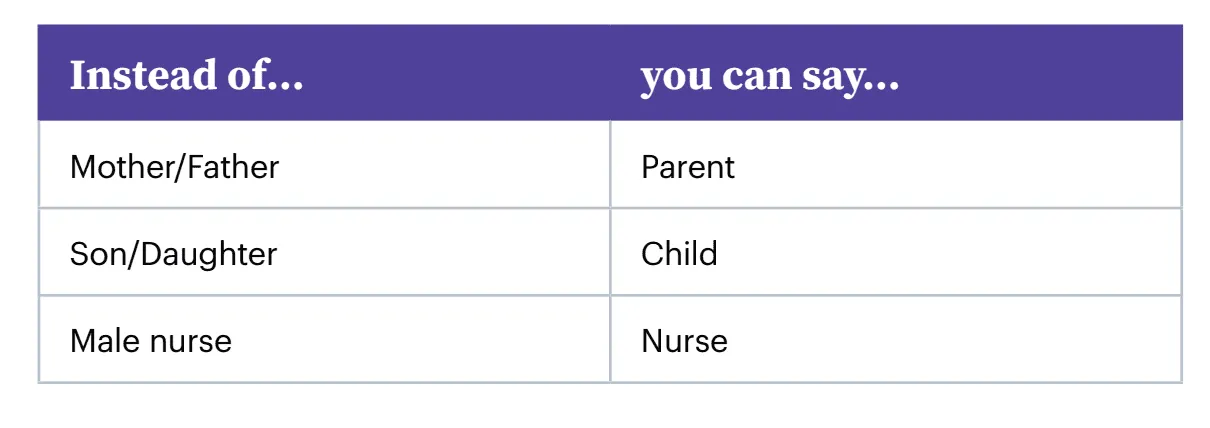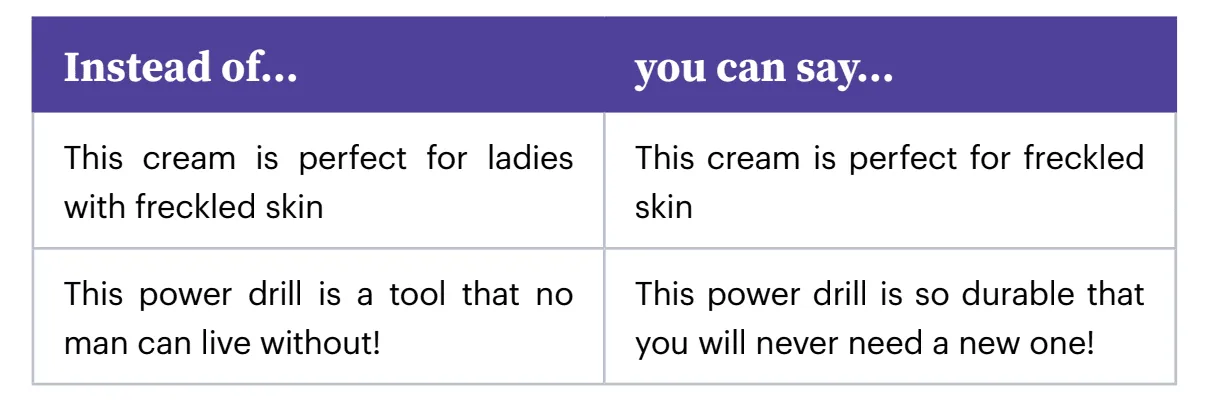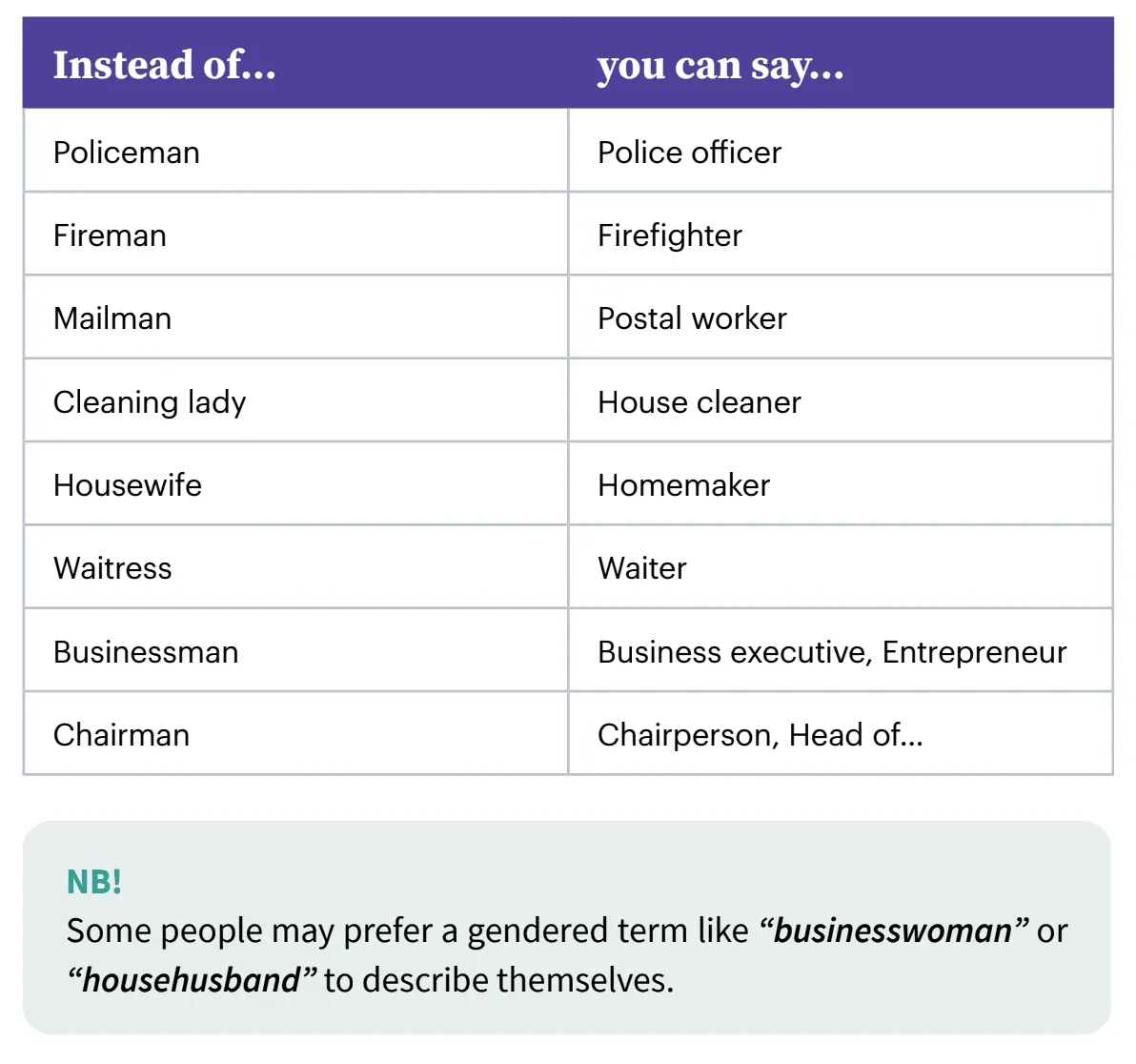How not to be sexist
9 practical tips from Writitude
Feel free to download the Anti-Sexism Tone of Voice Manual
This guide was written as a practical supplement to our blog article on anti-sexist copywriting.
Here you will find examples of phrases to be avoided in communication if you don’t want to sound sexist, and also suggestions on how to make your copy more gender-inclusive.
Sexism often goes hand in hand with transphobia. That’s why our guide includes recommendations for more gender-neutral communication (for English and other languages).
Of course, every single example is backed up by an explanation because we at Writitude take our words seriously.
- Decide whether gender is really relevant
- “Pink is for girls, chrome is for boys?”
- Make neutral pronouns your default choice
- For non-English writers: passive vs plural
- Be sensitive when asking people about their pronouns
- Sexist humour is never OK
- Be diverse with gender roles in your storytelling
- Use more inclusive forms of popular expressions
- Be clear about where you stand
Decide whether gender is really relevant
Although we do not argue with the reality of brand targeting, we are convinced that attracting one particular group of customers should not be achieved by excluding all the others.
We think any brand will benefit significantly from inclusive copy, as this will mean appealing to more customers.
That’s why we recommend always asking yourself whether it is essential to label your customer persona as “her” or “him” and whether it is really important to use gender-specific terms instead of neutral ones.

“Pink is for girls, chrome is for boys?”
Of course, the requirements may vary from brand to brand.
However, there is no need to make your copy gender-specific simply because it is for a product that is conventionally associated with just men or women.
Men deserve beauty products that take gentle care of their skin; women deserve powerful and durable tools to fix things around the house.
Viewing, buying or liking a product should not feel like barging into the wrong public bathroom.
There are many ways to convey the product’s benefits without gendering your prospective audience. Your customers’ personal qualities — like kindness, sensitivity, bravery or endurance — have no gender.
The same goes for their preferences for “delicate floral fragrances” or “sturdy chrome exteriors”.
It always makes more sense to focus on the particulars — either the benefits of your product or service or the specifics of the problem they are addressing.

Make neutral pronouns your default choice
Our stand on gender is pretty simple: everyone has a right to their own gender identity.
In most cases, we imply that the same piece of copy will be read by male, female and non-binary people. That’s why we will use the neutral “they” whenever possible.

For non-English writers: passive vs plural
The singular “they” has gained a truly neutral status in English, having gone from a linguistic innovation to a scholarly standard. However, not all languages have neutral pronouns that their users agree upon.
So what is a writer to do when they want to avoid gendered narrative, but there are no neutral pronouns in their language?
Sometimes when non-English writers aim for a gender-neutral narrative, they use the passive voice, e.g. “accounts can be created using your email” instead of “the client can create an account using his email”.
We, however, would advise against this practice. In most languages, the passive voice is a form reserved for legal and academic texts.
It, therefore, will sound out of place in your copy unless you are deliberately going for a rigid bureaucratic tone.
Instead, we advise using the plural form (“clients can use their emails to create new accounts”).
We know this solution isn’t perfect, as plural forms are gendered in many languages, too.
However, when you use the plural in your writing (clients), the reader will probably picture a multitude of clients of all genders, not an abstract male client, as it would be in the case of a singular noun.
(If there are no neutral pronouns in your language) 
Be sensitive when asking people about their pronouns
As societies and individuals across the globe are becoming more aware of transgender and non-binary identities, the question “What are your pronouns?” is going mainstream.
However, asking this question directly can often do more harm than good.
Not all transgender or non-binary people are comfortable with bringing up gender issues with a stranger, especially when the conversation is taking place in an environment which isn’t known to be trans- and non-binary-friendly.
However, when meeting someone, it is always a good idea to politely enquire how your counterpart identifies.
Instead of asking someone point-blank about their pronouns, you can enquire in a more general manner how they would like you to refer to them.
This will allow your vis-a-vis to clarify their pronouns for you if they feel the need to do so.

Sexist humour is never OK
Paradoxically, making a joke is one of the most serious decisions in copywriting.
Between individuals, humour comes naturally as a part of the conversation. The dynamics of brand communication are very different.
When you are a brand in a competitive environment, you are talking to a large group of individuals who are constantly re-evaluating their relationship with you.
They can choose to support you, leave you for another brand or even throw your company into the epicentre of a media storm.
That’s why we strongly recommend against using sarcastic or downright mean humour in your copy. Besides, when it comes to sexist jokes — they are not funny not only because they are offensive but because they are also trite.
“Female logic” and “man flu” — we’ve heard it so many times. “My husband’s face when I tell him I have nothing to wear”, “my wife’s face when I say I’ll be in my garage” — we’ve scrolled past memes like this a million times, and your customers will most likely do the same.
You may think we are discouraging you from using humour in your copy — quite the opposite. But please do not insult your audience or their intelligence.
Be diverse with gender roles in your storytelling
When you use storytelling in your writing, we encourage you to make your stories more diverse by attributing activities associated with one gender to characters of another gender. Feel free to use non-binary characters too!

Don’t rush to invent new terms
Stereotypes can be hard to get rid of, and many occupations historically reserved exclusively for men or women still carry gendered names.
However, when you want to use a gender-neutral name for occupation, we invite you to think (or Google) before you invent a new term like “police person”.
In most cases, you will find that a gender-neutral term has already been coined and adopted.

As mentioned above, politely enquiring how your counterpart identifies is always a good idea when meeting someone.

Use more inclusive forms of popular expressions
When you are in the writing business, you know the importance of idioms. They help us convey feelings and ideas, add imagery to our writing and are a great way to show off your erudition.
However, as language has been with us since time immemorial, many expressions we use also carry the stain of historical injustice. So whenever you are thinking of using an idiomatic expression, try to use an inclusive form.

Be clear where you stand
Now, when a large part of the world population has accepted the sad truth of discrimination, we are trying to right this global wrong. However, there is no way of telling how it should be done.
Do you use “Latinxs” or “people of Hispanic origin”? What about much-debated terms like “menstruating persons” or “people with uteruses”? On the one hand, these sound more trans-friendly than “female-bodied”; on the other hand, they reduce people’s essence to a bodily function.
While every brand is different and so we cannot provide a recipe that works for everyone, we are sure that consistency is the key. You may run with an entirely gender-neutral or gendered approach.
You may embrace the recently created suffixes and terms in your language or decide to communicate inclusivity with more conventional means.
Whatever you choose, your aim as a brand is to retain and grow your supportive audience.
By switching between several approaches, you will alienate the audience who supported you initially and earn even more distrust in the eyes of those who did not like you in the first place.
Clear communication guidelines, backed up by practical examples, will not only save you time and effort; they will also help you keep your integrity and build a mutually rewarding relationship with your customers and partners.

We hope that you found our guide useful. Writitude is always happy to be of help. Register a free account to experience how we help brands and copywriters create better content!


